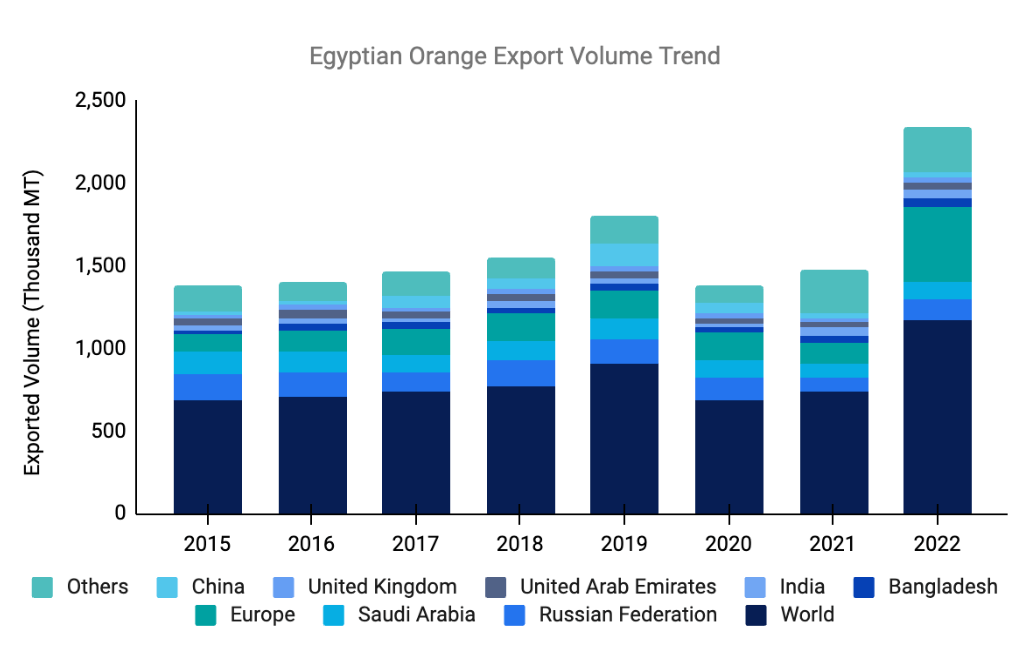Egyptian Orange Exports Boosts European Market Share

In the 2022/23 season, the European Union (EU) experienced a substantial surge in orange imports, marking a 22.4% increase, with a total of 613,597 metric tonnes (mt) imported from September to April. Among the key suppliers, South Africa played a leading role, contributing 46.5% to the total. However, the spotlight fell on Egypt, which provided 39.4%, showcasing a remarkable 40.3% increase from the average and fortifying its market share by an impressive 9 points.
Explosive Growth in Egyptian Orange Exports
For consecutive years, Egypt has maintained its status as the leading exporter of oranges, and the recent surge in EU imports underlines its growing significance. This uptick can be attributed to production challenges faced by other major orange-producing nations, particularly Morocco. The European citrus market witnessed a significant shift as buyers turned to Egyptian oranges amid production issues elsewhere.
The growth trajectory of Egyptian orange exports to European markets is nothing short of extraordinary, experiencing a staggering 279% increase over the last ten seasons. In the 2013/2014 export season, Egyptian orange exports were modest, not exceeding 121 thousand mt. Fast forward to the end of the 2021/22 season, and Egypt exported a substantial 458 thousand mt of oranges to Europe, showcasing an 83% YoY growth compared to the previous season. This surge meant that the Egyptian orange crop accounted for a remarkable 45% of the European Union’s total orange imports, which reached about one million mt during the year.

Spanish Citrus Production Woes
Spain, historically the largest orange producer in Europe, faced a challenging season with a decline of more than 22% YoY in orange production. Climate changes, coupled with an 8% reduction in the number of trees three seasons ago, contributed to a total production of 2.895 million tons. Adverse weather conditions, particularly excessive rainfall during flowering periods, further impacted the "Valencia" and "Andalusia" varieties.
This drop in Spanish citrus production had a cascading effect on international exports, witnessing a 15.4% decrease compared to the same period of the 2021/22 campaign and a 17.7% decline compared to the average of the last five years, totaling 1,084,070 tons. In response to the supply gap, Spanish imports of Egyptian oranges experienced a substantial surge from 250 tonnes to nearly 60,000 tonnes in the current season. The increased demand for Egypt’s high-quality citrus was fueled by adverse weather conditions affecting competitors in Spain, South Africa, and Morocco.
The decline in Spanish citrus production prompted major orange importers like Brazil to reassess their supply origins. Brazil, known for its strong juice processing industry, shifted its focus to importing Navels oranges from Egypt. Brazilian buyers are increasingly seeking volume-oriented programs from Egypt to meet their market demand, highlighting the flexibility and adaptability of the global orange trade.
Egypt's orange production has thrived in recent years, buoyed by optimal weather conditions and temperatures during the flowering of the trees. In the 2020/21 season, the volume of orange crop cultivations reached about 140 thousand hectares (ha), reflecting a 5.9% increase over the previous season. Productivity approached 3.17 million metric tons, a 2.2% increase. Today, Egypt's total planted area for oranges stands at about 152 thousand ha, up 4.5% YoY from the previous year.
Moroccan Factors in Orange Export Dynamics
A noteworthy factor contributing to the growth of Egyptian orange exports is the significant reduction in orange exports from Morocco. The first eight months of 2023 witnessed only 30 thousand mt of oranges, worth USD 13.7 million, exported from Morocco to foreign countries. In stark contrast, the same period of the previous year saw Moroccan orange exporters shipping 109,000 tonnes, generating export earnings of USD 71 million. Morocco, the third-largest orange-producing country in Africa, is set to significantly reduce its orange exports for various reasons, marking the lowest levels in at least eight years for the 2022/2023 season.
In conclusion, Egypt's burgeoning role in European orange imports underscores its resilience, adaptability, and consistent production quality. As global dynamics continue to shift, the Egyptian orange industry stands as a key player, influencing market trends and contributing significantly to the European orange market share.





